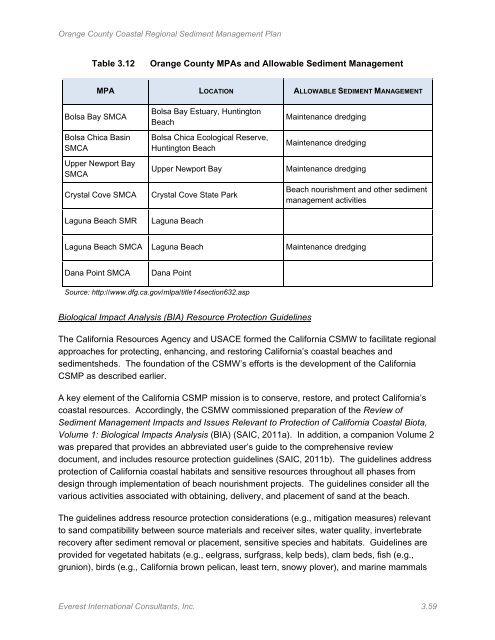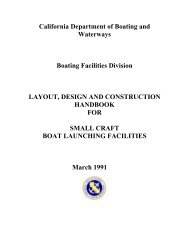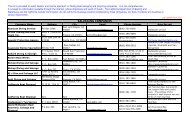EVEREST June, 2013 - California Department of Boating and ...
EVEREST June, 2013 - California Department of Boating and ...
EVEREST June, 2013 - California Department of Boating and ...
You also want an ePaper? Increase the reach of your titles
YUMPU automatically turns print PDFs into web optimized ePapers that Google loves.
Orange County Coastal Regional Sediment Management Plan<br />
Table 3.12<br />
Orange County MPAs <strong>and</strong> Allowable Sediment Management<br />
MPA LOCATION ALLOWABLE SEDIMENT MANAGEMENT<br />
Bolsa Bay SMCA<br />
Bolsa Chica Basin<br />
SMCA<br />
Upper Newport Bay<br />
SMCA<br />
Crystal Cove SMCA<br />
Laguna Beach SMR<br />
Bolsa Bay Estuary, Huntington<br />
Beach<br />
Bolsa Chica Ecological Reserve,<br />
Huntington Beach<br />
Upper Newport Bay<br />
Crystal Cove State Park<br />
Laguna Beach<br />
Maintenance dredging<br />
Maintenance dredging<br />
Maintenance dredging<br />
Beach nourishment <strong>and</strong> other sediment<br />
management activities<br />
Laguna Beach SMCA Laguna Beach Maintenance dredging<br />
Dana Point SMCA<br />
Dana Point<br />
Source: http://www.dfg.ca.gov/mlpa/title14section632.asp<br />
Biological Impact Analysis (BIA) Resource Protection Guidelines<br />
The <strong>California</strong> Resources Agency <strong>and</strong> USACE formed the <strong>California</strong> CSMW to facilitate regional<br />
approaches for protecting, enhancing, <strong>and</strong> restoring <strong>California</strong>’s coastal beaches <strong>and</strong><br />
sedimentsheds. The foundation <strong>of</strong> the CSMW’s efforts is the development <strong>of</strong> the <strong>California</strong><br />
CSMP as described earlier.<br />
A key element <strong>of</strong> the <strong>California</strong> CSMP mission is to conserve, restore, <strong>and</strong> protect <strong>California</strong>’s<br />
coastal resources. Accordingly, the CSMW commissioned preparation <strong>of</strong> the Review <strong>of</strong><br />
Sediment Management Impacts <strong>and</strong> Issues Relevant to Protection <strong>of</strong> <strong>California</strong> Coastal Biota,<br />
Volume 1: Biological Impacts Analysis (BIA) (SAIC, 2011a). In addition, a companion Volume 2<br />
was prepared that provides an abbreviated user’s guide to the comprehensive review<br />
document, <strong>and</strong> includes resource protection guidelines (SAIC, 2011b). The guidelines address<br />
protection <strong>of</strong> <strong>California</strong> coastal habitats <strong>and</strong> sensitive resources throughout all phases from<br />
design through implementation <strong>of</strong> beach nourishment projects. The guidelines consider all the<br />
various activities associated with obtaining, delivery, <strong>and</strong> placement <strong>of</strong> s<strong>and</strong> at the beach.<br />
The guidelines address resource protection considerations (e.g., mitigation measures) relevant<br />
to s<strong>and</strong> compatibility between source materials <strong>and</strong> receiver sites, water quality, invertebrate<br />
recovery after sediment removal or placement, sensitive species <strong>and</strong> habitats. Guidelines are<br />
provided for vegetated habitats (e.g., eelgrass, surfgrass, kelp beds), clam beds, fish (e.g.,<br />
grunion), birds (e.g., <strong>California</strong> brown pelican, least tern, snowy plover), <strong>and</strong> marine mammals<br />
Everest International Consultants, Inc. 3.59




